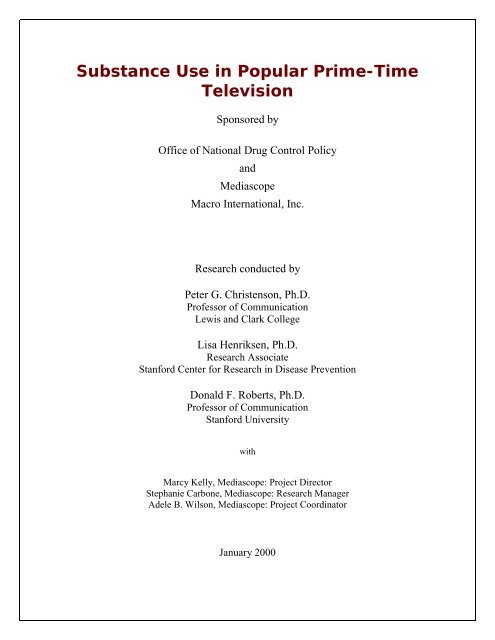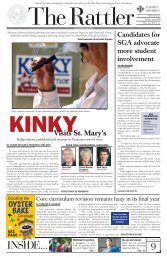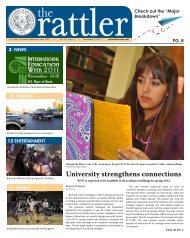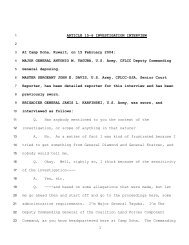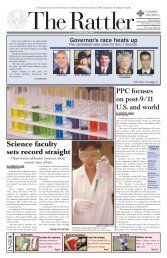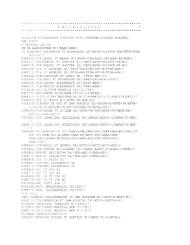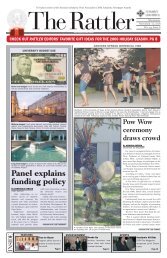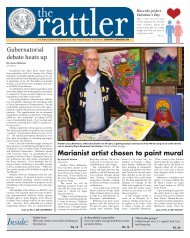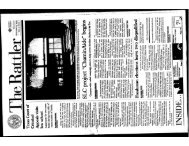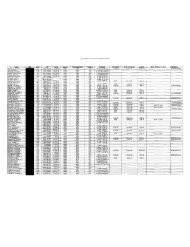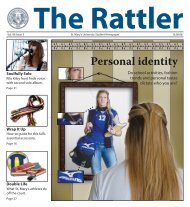Substance Use in Popular Prime-Time Television
Substance Use in Popular Prime-Time Television
Substance Use in Popular Prime-Time Television
Create successful ePaper yourself
Turn your PDF publications into a flip-book with our unique Google optimized e-Paper software.
<strong>Substance</strong> <strong>Use</strong> <strong>in</strong> <strong>Popular</strong> <strong>Prime</strong>-<strong>Time</strong><br />
<strong>Television</strong><br />
Sponsored by<br />
Office of National Drug Control Policy<br />
and<br />
Mediascope<br />
Macro International, Inc.<br />
Research conducted by<br />
Peter G. Christenson, Ph.D.<br />
Professor of Communication<br />
Lewis and Clark College<br />
Lisa Henriksen, Ph.D.<br />
Research Associate<br />
Stanford Center for Research <strong>in</strong> Disease Prevention<br />
Donald F. Roberts, Ph.D.<br />
Professor of Communication<br />
Stanford University<br />
with<br />
Marcy Kelly, Mediascope: Project Director<br />
Stephanie Carbone, Mediascope: Research Manager<br />
Adele B. Wilson, Mediascope: Project Coord<strong>in</strong>ator<br />
January 2000
<strong>Substance</strong> <strong>Use</strong> <strong>in</strong> <strong>Popular</strong> <strong>Prime</strong>-<strong>Time</strong><br />
<strong>Television</strong><br />
Table of Contents<br />
SUBSTANCE USE IN POPULAR PRIME-TIME TELEVISION ......................................................................... I<br />
TABLE OF CONTENTS..................................................................................................................................................i<br />
EXECUTIVE SUMMARY .........................................................................................................................................1<br />
TOP-TEEN VS. TOP-ADULT EPISODES........................................................................................................................3<br />
MAJOR CHARACTERS.................................................................................................................................................3<br />
CONCLUSIONS............................................................................................................................................................3<br />
Illicit Drugs ..........................................................................................................................................................3<br />
Tobacco ................................................................................................................................................................4<br />
Alcohol .................................................................................................................................................................4<br />
RATIONALE AND BACKGROUND .......................................................................................................................5<br />
INTRODUCTION ..........................................................................................................................................................5<br />
<strong>Substance</strong> <strong>Use</strong> Among American Youth................................................................................................................6<br />
<strong>Television</strong> and Adolescents...................................................................................................................................6<br />
Previous Research on <strong>Television</strong> <strong>Substance</strong> Portrayals.......................................................................................7<br />
METHODS...................................................................................................................................................................9<br />
THE SAMPLE ..............................................................................................................................................................9<br />
CODING PROCEDURES..............................................................................................................................................11<br />
Episodes .............................................................................................................................................................12<br />
Major Characters ...............................................................................................................................................13<br />
Screen <strong>Time</strong> ........................................................................................................................................................13<br />
Commercials and Other Non-Program Content.................................................................................................14<br />
RESULTS...................................................................................................................................................................15<br />
SUBSTANCE USE IN PROGRAM CONTENT.................................................................................................................17<br />
Frequency of <strong>Substance</strong> <strong>Use</strong> ..............................................................................................................................19<br />
Context of <strong>Substance</strong> <strong>Use</strong> ...................................................................................................................................27<br />
SUBSTANCE USE IN COMMERCIAL CONTENT...........................................................................................................31<br />
COMPARING TELEVISION AND MOVIES .......................................................................................................35<br />
REFERENCES ....................................................................................................................................................... R-1<br />
APPENDIX A: PRIME-TIME TELEVISION STUDY SAMPLE..................................................................... A-1<br />
APPENDIX B: ADOLESCENTS AND TELEVISION........................................................................................B-1<br />
January 2000 <strong>Substance</strong> <strong>Use</strong> <strong>in</strong> <strong>Popular</strong> <strong>Prime</strong>-<strong>Time</strong> <strong>Television</strong> Page i
A<br />
Executive Summary<br />
lthough there is much speculation about whether television <strong>in</strong>fluences<br />
adolescent substance use, careful exam<strong>in</strong>ation of television content is a<br />
crucial first step <strong>in</strong> determ<strong>in</strong><strong>in</strong>g what <strong>in</strong>fluence, if any, might be attributed to<br />
the medium. This study addresses a s<strong>in</strong>gle research question: How are illicit<br />
drugs, tobacco, and alcohol portrayed <strong>in</strong> the most popular television series<br />
Specifically, this study exam<strong>in</strong>ed the frequency and nature of substance use<br />
portrayals <strong>in</strong> the top-rated, prime-time shows of the fall 1998-1999 season.<br />
The study sample, based on Nielsen Media Research rat<strong>in</strong>gs, was comprised of<br />
four consecutive episodes from 42 top-rated situation comedies and dramas -- a<br />
total of 168 episodes. The sample <strong>in</strong>cluded the 20 most popular shows among<br />
teenagers and among adults, as well as the 20 most popular shows among African-<br />
American teens, among Hispanic teens and among white teens.<br />
<strong>Substance</strong>s <strong>in</strong>cluded <strong>in</strong> the study were illicit drugs, alcohol, tobacco, and over-the-counter and<br />
prescription medic<strong>in</strong>es. Researchers exam<strong>in</strong>ed what substances were used, by whom, how often,<br />
under what circumstances and with what consequences. The study considered whether television<br />
<strong>in</strong>volved substance use as an important theme, conta<strong>in</strong>ed pro- or anti-use behavior or statements, or<br />
conveyed limit-sett<strong>in</strong>g messages. Also exam<strong>in</strong>ed was the extent to which substance use portrayals<br />
varied among television series with different parental advisory labels, as well as the frequency of<br />
substance references <strong>in</strong> television advertisements. F<strong>in</strong>ally, researchers compared television<br />
depictions with those found <strong>in</strong> the 200 most popular movie rentals of 1996 and 1997, which were<br />
exam<strong>in</strong>ed <strong>in</strong> last year’s study, <strong>Substance</strong> <strong>Use</strong> <strong>in</strong> <strong>Popular</strong> Movies and Music. 1<br />
F<strong>in</strong>d<strong>in</strong>gs revealed that illicit drugs were mentioned or seen <strong>in</strong> 20 percent of all episodes, tobacco<br />
<strong>in</strong> 22 percent, and alcohol <strong>in</strong> 77 percent. Illicit drug use was shown <strong>in</strong> only six episodes overall<br />
(3 percent). Illicit drug use by major characters was seldom observed. More than one-third of<br />
the episodes (41 percent) that mentioned or showed illicit drugs conta<strong>in</strong>ed at least one negative<br />
statement about them. Four of the six episodes that showed illicit drug use mentioned some k<strong>in</strong>d<br />
of negative consequence.<br />
Tobacco was used <strong>in</strong> 19 percent of episodes. No teenage characters were observed smok<strong>in</strong>g. Almost<br />
one-fourth of the episodes that portrayed tobacco use (23 percent) expressed a negative statement<br />
1 Roberts, D.F., Henriksen, L., Christenson, P. (1999). <strong>Substance</strong> <strong>Use</strong> <strong>in</strong> <strong>Popular</strong> Movies and Music, Office of<br />
National Drug Control Policy, Mediascope.<br />
January 2000 <strong>Substance</strong> <strong>Use</strong> <strong>in</strong> <strong>Popular</strong> <strong>Prime</strong>-<strong>Time</strong> <strong>Television</strong> Page 1
about smok<strong>in</strong>g; positive statements occurred <strong>in</strong> four episodes (13 percent). Negative consequences<br />
of smok<strong>in</strong>g were mentioned or portrayed <strong>in</strong> only two of the episodes that portrayed tobacco use.<br />
Alcohol was consumed <strong>in</strong> 71 percent of all episodes, <strong>in</strong>clud<strong>in</strong>g 65 percent of the top-teen episodes.<br />
Note that the term “top-teen episodes” refers to shows popular with teenagers, not necessarily<br />
produced for teenagers. Dr<strong>in</strong>k<strong>in</strong>g by underage characters was rarely shown. Only 6 percent of the<br />
top-teen and 3 percent of top-adult episodes portrayed alcohol use by characters under 18. Just one<br />
of these was a major character. About one-third of all episodes were set <strong>in</strong> bars, nightclubs, or<br />
restaurants where alcohol was consumed. More episodes made dr<strong>in</strong>k<strong>in</strong>g alcohol look like a positive<br />
experience (40 percent of episodes that portrayed alcohol use) than a negative experience (10<br />
percent). Nearly half of the episodes (45 percent) that portrayed alcohol use associated it with<br />
humor. Negative consequences of alcohol use were either mentioned or shown <strong>in</strong> almost one-fourth<br />
(23 percent) of the episodes that portrayed alcohol use.<br />
There were few differences <strong>in</strong> substance use portrayals among the shows most popular with different<br />
teenage ethnic groups. The frequency of illicit drug portrayals was roughly the same for episodes<br />
popular with African-American, Hispanic and white teens. However, episodes popular with African-<br />
American teens were less likely to mention and depict tobacco use, and episodes popular with white<br />
teens were somewhat more likely to conta<strong>in</strong> dialogue referr<strong>in</strong>g to excessive dr<strong>in</strong>k<strong>in</strong>g.<br />
Commercials for alcoholic beverages appeared <strong>in</strong> only 9 percent of all episodes studied. However,<br />
alcohol use appeared <strong>in</strong> ads for other products, such as restaurants, credit cards and hotels: 59 percent<br />
of top-teen and 60 percent of top-adult episodes conta<strong>in</strong>ed one or more ads of this sort. Alcohol also<br />
appeared <strong>in</strong> network spots promot<strong>in</strong>g upcom<strong>in</strong>g programs: 50 percent of top-teen and 63 percent of<br />
top-adult episodes <strong>in</strong>cluded one or more promotional spots that portrayed alcohol use. Ads for<br />
prescription medic<strong>in</strong>es appeared <strong>in</strong> 14 percent of all episodes. Anti-drug ads appeared <strong>in</strong> 16 percent<br />
of top-teen episodes, and anti-smok<strong>in</strong>g ads appeared <strong>in</strong> 11 percent.<br />
Compar<strong>in</strong>g these results to our earlier study of movies, illicit drugs were substantially less likely<br />
to be portrayed <strong>in</strong> television series than <strong>in</strong> movies. When illicit drugs were referred to, television<br />
was more likely to associate them with anti-use statements and negative consequences, and less<br />
likely to l<strong>in</strong>k them to pro-use statements. F<strong>in</strong>ally, young viewers were considerably less likely to<br />
see smok<strong>in</strong>g on television than <strong>in</strong> movies, and somewhat less likely to see alcohol consumption.<br />
Follow<strong>in</strong>g are additional highlights from the study:<br />
! Illicit drugs were used <strong>in</strong> 3 percent of all episodes, tobacco <strong>in</strong> 19 percent, and alcohol <strong>in</strong> 71<br />
percent.<br />
! Major characters were shown us<strong>in</strong>g illicit drugs <strong>in</strong> 2 percent of all episodes, tobacco <strong>in</strong> 11<br />
percent, and alcohol <strong>in</strong> 56 percent.<br />
! Humorous references to substances were commonplace, occurr<strong>in</strong>g <strong>in</strong> at least half of all<br />
episodes (49 percent). Alcohol was joked about most often -- <strong>in</strong> 35 percent of all episodes.<br />
About 10 percent of episodes made humorous references to either illicit drugs or tobacco.<br />
January 2000 <strong>Substance</strong> <strong>Use</strong> <strong>in</strong> <strong>Popular</strong> <strong>Prime</strong>-<strong>Time</strong> <strong>Television</strong> Page 2
! Negative statements about substance use (advocat<strong>in</strong>g abst<strong>in</strong>ence or criticiz<strong>in</strong>g dr<strong>in</strong>k<strong>in</strong>g,<br />
smok<strong>in</strong>g, or drug use) occurred <strong>in</strong> 14 percent of all episodes.<br />
! About one-fourth of all episodes (26 percent) portrayed at least one negative consequence of<br />
substance use.<br />
Top-Teen vs. Top-Adult Episodes<br />
! Illicit drugs were mentioned <strong>in</strong> 21 percent of top-teen episodes and 20 percent of top-adult<br />
episodes.<br />
! Alcohol use was portrayed <strong>in</strong> more episodes popular with adults (81 percent) than with teens<br />
(65 percent).<br />
! Major characters consumed alcohol <strong>in</strong> 53 percent of top-teen and 70 percent of top-adult<br />
episodes.<br />
! Twenty percent of top-teen and 23 percent of top-adult episodes portrayed tobacco use.<br />
Major Characters<br />
! Only three major characters were shown us<strong>in</strong>g illicit drugs. One teen and one adult male<br />
used marijuana. One female teen consumed a dr<strong>in</strong>k that someone else had drugged.<br />
! None of the major characters under 18 smoked cigarettes, only one drank alcohol, and 75<br />
percent drank non-alcoholic beverages.<br />
! None of the major characters attempted to quit dr<strong>in</strong>k<strong>in</strong>g or smok<strong>in</strong>g on screen. Two adults<br />
described themselves as former alcoholics; none described themselves as hav<strong>in</strong>g quit or<br />
hav<strong>in</strong>g tried to quit us<strong>in</strong>g illicit drugs or tobacco.<br />
Conclusions<br />
Illicit Drugs<br />
Illicit drugs were <strong>in</strong>frequently mentioned and rarely shown <strong>in</strong> prime time television. In the few<br />
episodes that portrayed illicit drug use, nearly all showed negative consequences. Typically, major<br />
characters were not shown us<strong>in</strong>g illicit drugs or communicat<strong>in</strong>g pro-use statements. However, a<br />
number of humorous references to illicit drugs occurred.<br />
January 2000 <strong>Substance</strong> <strong>Use</strong> <strong>in</strong> <strong>Popular</strong> <strong>Prime</strong>-<strong>Time</strong> <strong>Television</strong> Page 3
Overall, teen viewers were exposed to very little illicit drug use and, what little there was, did not<br />
glamorize drugs.<br />
Tobacco<br />
One <strong>in</strong> five episodes (19 percent) portrayed tobacco use. No characters under the age of 18 were<br />
shown us<strong>in</strong>g tobacco. Eight percent of adult major characters used tobacco. Twenty-three percent of<br />
episodes that showed tobacco use expressed negative statements about smok<strong>in</strong>g.<br />
Overall, teen viewers were exposed to relatively little tobacco use. These episodes avoided underage<br />
tobacco use and presented adult use to a limited extent.<br />
Alcohol<br />
A significant number of episodes (71 percent) showed alcohol use. With one exception, no dr<strong>in</strong>k<strong>in</strong>g<br />
by underage characters was portrayed. However, a large proportion of adult major characters (66<br />
percent) drank alcohol onscreen. Nearly half of the episodes that showed alcohol use associated it<br />
with humor. Of the episodes that portrayed alcohol use, negative consequences were shown <strong>in</strong> 23<br />
percent and refusal to use <strong>in</strong> 1 percent.<br />
On the whole, teen viewers were exposed to high levels of alcohol use. More episodes made<br />
dr<strong>in</strong>k<strong>in</strong>g alcohol look like a positive experience (40 percent) than a negative experience (10 percent).<br />
January 2000 <strong>Substance</strong> <strong>Use</strong> <strong>in</strong> <strong>Popular</strong> <strong>Prime</strong>-<strong>Time</strong> <strong>Television</strong> Page 4
Rationale and Background<br />
Introduction<br />
T<br />
here is ample evidence that exposure to mass media messages <strong>in</strong>fluences<br />
young viewers’ attitudes and values <strong>in</strong> a number of doma<strong>in</strong>s. 2,3,4 There is also<br />
concern that media portrayals may <strong>in</strong>fluence young people’s attitudes and<br />
behavior toward substance use. 5 Of all the media command<strong>in</strong>g the attention of<br />
American adolescents, television probably has the greatest potential for exert<strong>in</strong>g<br />
such <strong>in</strong>fluence. What messages does television make available to young people<br />
about alcohol, tobacco and illicit drugs The major aim of this study is to provide<br />
a systematic, detailed picture of substance use as portrayed <strong>in</strong> the television shows<br />
most popular among adolescents and adults.<br />
Document<strong>in</strong>g the frequency and nature of substance use portrayals is a necessary first step <strong>in</strong><br />
explor<strong>in</strong>g television’s role <strong>in</strong> form<strong>in</strong>g young people’s substance use attitudes and behavior. The<br />
ultimate effects of any media <strong>in</strong>formation, whether from television, popular music, motion pictures<br />
or any other medium, depend on a variety of factors. These <strong>in</strong>clude <strong>in</strong>dividual differences <strong>in</strong><br />
<strong>in</strong>terpretation, the <strong>in</strong>fluence of compet<strong>in</strong>g <strong>in</strong>formation from parents or peers, and variations <strong>in</strong> social<br />
and cultural background. Exam<strong>in</strong><strong>in</strong>g media messages is essential to understand<strong>in</strong>g the myriad<br />
processes that determ<strong>in</strong>e whether a young person will engage <strong>in</strong> alcohol, tobacco or illicit drug use.<br />
If substance use is depicted frequently and positively <strong>in</strong> the television shows young people watch,<br />
then it makes sense to raise questions about the role of these depictions <strong>in</strong> encourag<strong>in</strong>g substance use.<br />
If, on the other hand, substance use is portrayed rarely and negatively, then it makes little sense to<br />
attribute adolescents’ substance use to the effects of television. Indeed, if substance use is presented<br />
as dangerous, unglamorous, or socially unacceptable, then television’s role may be positive, its<br />
messages work<strong>in</strong>g to discourage, rather than encourage, use.<br />
2 Comstock, G., with Paik, H. (1991). <strong>Television</strong> and the American Child. San Diego, CA: Academic Press.<br />
3 Christenson, P. G., & Roberts, D. F. (1998). It’s not only rock & roll: <strong>Popular</strong> music <strong>in</strong> the lives of adolescents.<br />
New Jersey: Hampton Press, Inc.<br />
4 Roberts, D.F. (1993). Adolescents and the mass media: From “Leave It to Beaver” to “Beverly Hills, 90210.”<br />
Teachers College Record, 94 (3), 629-643.<br />
5 Strasburger, V. (1995) Adolescents and the mass media: Medical and psychological impact. Thousand Oaks,<br />
CA: Sage.<br />
January 2000 <strong>Substance</strong> <strong>Use</strong> <strong>in</strong> <strong>Popular</strong> <strong>Prime</strong>-<strong>Time</strong> <strong>Television</strong> Page 5
It is also important to recognize that adolescents watch different shows than adults, and that different<br />
groups of adolescents have dist<strong>in</strong>ct view<strong>in</strong>g patterns. Hence, this study compares the top-rated<br />
shows for adolescents with the top-rated shows among adults. In addition, the favorite shows among<br />
three sub-groups of adolescents — African Americans, Hispanics and whites — are also compared.<br />
This is the first study of substance portrayals to contrast these samples.<br />
<strong>Substance</strong> <strong>Use</strong> Among American Youth<br />
The U.S. faces problematic rates of illicit drug, alcohol and tobacco use among youth. In 1999, 55<br />
percent of high school seniors reported hav<strong>in</strong>g used an illegal drug at least once, as did 46 percent of<br />
tenth and 28 percent of eighth graders. 6 Among adolescents ages 12 to 17, the average ages of first<br />
use of marijuana, coca<strong>in</strong>e, and hero<strong>in</strong> were 14, 15 and 14 years, respectively. 7 Youth tobacco<br />
smok<strong>in</strong>g rates are higher now than at any time <strong>in</strong> the past 17 years. Two-thirds of U.S. high school<br />
students have tried cigarettes and more than one-third currently smoke. 8 Every day another 3,000<br />
American children and teenagers become regular smokers. 9<br />
Alcohol consumption among adolescents rema<strong>in</strong>s at high levels. Eighty percent of U.S. high school<br />
students have tried alcohol and 51 percent of students are current dr<strong>in</strong>kers; 10 <strong>in</strong> 1997, more than 31<br />
percent of 12th graders, 25 percent of 10th graders, and 14 percent of 8th graders claimed to have<br />
consumed five or more alcoholic dr<strong>in</strong>ks <strong>in</strong> the preced<strong>in</strong>g two weeks. 11 Perhaps most disturb<strong>in</strong>g,<br />
among 12- to 17-year-olds who exhibit no other problem behaviors, those who have used marijuana,<br />
alcohol, or cigarettes <strong>in</strong> the past month are 17 times more likely to later consume drugs such as<br />
coca<strong>in</strong>e, hero<strong>in</strong> or LSD than those who have not used marijuana, alcohol or cigarettes. 12<br />
<strong>Television</strong> and Adolescents<br />
American adolescents spend a good deal of time us<strong>in</strong>g mass media, and television is the medium they<br />
use most. A national study of childhood and adolescent media use sponsored by the Kaiser Family<br />
6 Johnston, L.D., O'Malley, P.M., & Bachman, J.G. (1999). National Survey Results on Drug <strong>Use</strong> from the<br />
Monitor<strong>in</strong>g the Future Study, 1975-1998 Volume I: Secondary School Students. Rockville, MD: U.S. Department<br />
of Health and Human Services, National Institute on Drug Abuse.<br />
7<br />
National Household Survey on Drug Abuse. (1997). Rockville, MD: Office of Applied Studies, <strong>Substance</strong> Abuse<br />
and Mental Health Services Adm<strong>in</strong>istration.<br />
8<br />
Ozer, E. M., Br<strong>in</strong>dis, C. D., Millste<strong>in</strong>, S. G., Knopf, D. K., & Irw<strong>in</strong>, C. E., Jr. (1997). America’s Adolescents: Are<br />
they Healthy San Francisco, CA: University of California at San Francisco, National Adolescent Health<br />
Information Center.<br />
9<br />
The National Center on Addiction and <strong>Substance</strong> Abuse at Columbia University 1995 Annual Report. (1996).<br />
New York: Columbia University, National Center on Addiction and <strong>Substance</strong> Abuse at Columbia University.<br />
10 Youth Risk Behavior Surveillance: United States, 1997. (1998). Atlanta, GA: Epidemiology Program Office,<br />
Centers for Disease Control and Prevention (CDC), U.S. Department of Health and Human Services, MMWR<br />
47(SS-3).<br />
11<br />
Johnston, L. D., O’Malley, P. M., & Bachman, J. G., op cit.<br />
12<br />
<strong>Substance</strong> Abuse and the American Adolescent: A Report by the Commission on <strong>Substance</strong> Abuse Among<br />
America’s Adolescents. (1997). New York: National Center on Addiction and <strong>Substance</strong> Abuse at Columbia<br />
University.<br />
January 2000 <strong>Substance</strong> <strong>Use</strong> <strong>in</strong> <strong>Popular</strong> <strong>Prime</strong>-<strong>Time</strong> <strong>Television</strong> Page 6
Foundation reported that young people ages 8 to 18 years spend more than three hours a day<br />
watch<strong>in</strong>g television. This is about three times the time expenditure for radio, the closest competitor<br />
<strong>in</strong> the study. View<strong>in</strong>g hours and preferences differed significantly by ethnicity. African Americans<br />
watched the most, just over 4 hours and 40 m<strong>in</strong>utes per day. Hispanic youth averaged 3 hours and 50<br />
m<strong>in</strong>utes, and white youth watched just under 3 hours. Situation comedy and drama were the most<br />
popular types of programs for all three groups, but whites were disproportionately attracted to drama<br />
compared to the other two groups. 13<br />
Perhaps no other question <strong>in</strong> communication research has been studied more than the impact of<br />
television on children and adolescents. Although there may be disagreement on the size of the<br />
<strong>in</strong>fluence and whether it is, on balance, positive or negative, there can be no serious doubt that<br />
television plays a role <strong>in</strong> the process of socialization. 14,15,16 Furthermore, evidence is mount<strong>in</strong>g that<br />
<strong>in</strong>creased television view<strong>in</strong>g is a risk factor for the onset of alcohol use <strong>in</strong> adolescents. 17,18,19<br />
Previous Research on <strong>Television</strong> <strong>Substance</strong><br />
Portrayals<br />
The majority of the systematic analyses of substance use portrayals on television have focused on<br />
alcohol. While these reports are difficult to compare due to <strong>in</strong>consistencies <strong>in</strong> methods and<br />
measurements, they do establish that references to alcohol use—either visual, verbal, or both —<br />
occur several times dur<strong>in</strong>g an average hour of prime-time television programm<strong>in</strong>g. The group of<br />
studies that provide the most reliable historical comparisons suggest a trend toward more frequent<br />
alcohol portrayals <strong>in</strong> the late 1970s and early 1980s, followed by an apparent decl<strong>in</strong>e <strong>in</strong> these<br />
portrayals between 1984 and 1986. Even <strong>in</strong> the 1986 programm<strong>in</strong>g, however, over three-fourths of<br />
prime-time drama episodes had references to alcohol, and portrayals of actual consumption appeared<br />
<strong>in</strong> about half. 20 More recent studies confirm that the depiction of alcohol use is a regular occurrence<br />
on television. 21<br />
13 Roberts, D.F., Foehr, U.G., Rideout, V.J., & Brodie, M. (1999). Kids and Media at the New Millennium:<br />
Executive Summary. Menlo Park, CA: The Henry J. Kaiser Family Foundation.<br />
14 Comstock with Paik, op. cit.<br />
15 Roberts, 1993, op. cit.<br />
16 Strasburger, V. (1995) Adolescents and the mass media: Medical and psychological impact. Thousand Oaks,<br />
CA: Sage.<br />
17 Kotch, J.B., Coulter, M.L., & Lipsitz, A. (1986). Does televised dr<strong>in</strong>k<strong>in</strong>g <strong>in</strong>fluence children's attitudes toward<br />
alcohol Addictive Behaviors, 11(1), 67-70.<br />
18 Rob<strong>in</strong>son, T.N., Chen, H.L., & Killen, J.D. (1998). <strong>Television</strong> and music video exposure and risk of adolescent<br />
alcohol use. Pediatrics, 102, 1-6.<br />
19 Rychtarik, R.G., Fairbank, J.A., Allen, C.M., Fox., D.W., & Drabman, R.S. (1993). Alcohol use <strong>in</strong> television<br />
programm<strong>in</strong>g: Effects on children's behavior. Addictive Behaviors, 8(1), 19-22.<br />
20 Wallack, L., Grube, J.W., Madden, P.A., and Breed, W. (1990) Portrayals of alcohol on prime-time television.<br />
Journal of Studies on Alcohol, 51(5), pp. 428-437<br />
21 Mathios, A., Avery, R., Biscogni, C., and Shanahan, J. (1998). Alcohol portrayal on prime-time television:<br />
Manifest and latent messages. Journal of Studies on Alcohol, 59, pp. 305-310.<br />
January 2000 <strong>Substance</strong> <strong>Use</strong> <strong>in</strong> <strong>Popular</strong> <strong>Prime</strong>-<strong>Time</strong> <strong>Television</strong> Page 7
Equally important as the frequency of alcohol portrayals is the nature of those portrayals. Here the<br />
research suggests that alcohol consumption usually appears on television as a background activity.<br />
That is, characters dr<strong>in</strong>k or talk about dr<strong>in</strong>k<strong>in</strong>g <strong>in</strong> the context of other activities, without the<br />
attachment of any direct message, either pro or con, about alcohol consumption. Dr<strong>in</strong>k<strong>in</strong>g, accord<strong>in</strong>g<br />
to the exist<strong>in</strong>g research, has generally been presented as a rout<strong>in</strong>e, problem-free activity. Those who<br />
dr<strong>in</strong>k on television are more likely to be central characters, more attractive, and of higher status than<br />
those who do not dr<strong>in</strong>k. References to the negative consequences of dr<strong>in</strong>k<strong>in</strong>g are rare. 22,23,24<br />
Only a few studies have looked at tobacco portrayals. In studies us<strong>in</strong>g comparable measures,<br />
smok<strong>in</strong>g has appeared about one-tenth as often as alcohol. The research shows a sharp decl<strong>in</strong>e <strong>in</strong><br />
tobacco use on television from the 1950s through the early 1980s, followed by a small <strong>in</strong>crease<br />
through the early 1990s. As with alcohol, smok<strong>in</strong>g is more often associated with important, positive<br />
characters than peripheral, negative characters. 25,26<br />
Only two studies of illicit drug portrayals, both published <strong>in</strong> the 1970s, were found. At that time,<br />
illicit drug references of any k<strong>in</strong>d — verbal or visual — were quite rare, occurr<strong>in</strong>g only once <strong>in</strong> every<br />
five hours of prime-time programm<strong>in</strong>g. 27<br />
22 Mathios, op. cit.<br />
23 Signorelli, N. (1987). Dr<strong>in</strong>k<strong>in</strong>g, sex and violence on television: The cultural <strong>in</strong>dicators perspective. Journal of<br />
Drug Education, 17(3), 245-60.<br />
24 Wallack, L., Grube, J.W., Madden, P.A., and Breed, W. (1990) Portrayals of alcohol on prime-time television.<br />
Journal of Studies on Alcohol, 51(5), pp. 428-437.<br />
25 Cruz, J., & Wallack, L. (1986). Trends <strong>in</strong> tobacco use on television. American Journal of Public Health, 76(6),<br />
698-699.<br />
26 Hazan, A. R., & Glantz, S.A. (1995). Current trends <strong>in</strong> tobacco use on prime-time fictional television. American<br />
Journal of Public Health, 85(1), 116-117.<br />
27 Fernandez-Collado, C.F., Greenberg, B.S., Korzenny, F., & Atk<strong>in</strong>, C. K. (1978). Sexual <strong>in</strong>timacy and drug use <strong>in</strong><br />
TV series. Journal of Communication, 28(3), 31-37.<br />
January 2000 <strong>Substance</strong> <strong>Use</strong> <strong>in</strong> <strong>Popular</strong> <strong>Prime</strong>-<strong>Time</strong> <strong>Television</strong> Page 8
Methods<br />
The Sample<br />
A<br />
lthough there is much speculation about whether television <strong>in</strong>fluences<br />
adolescent substance use, careful exam<strong>in</strong>ation of television content is a<br />
crucial first step <strong>in</strong> determ<strong>in</strong><strong>in</strong>g what <strong>in</strong>fluence, if any, might be attributed to<br />
the medium. This study addresses a s<strong>in</strong>gle research question: How are illicit<br />
drugs, tobacco, and alcohol portrayed <strong>in</strong> the most popular television series<br />
Specifically, this study exam<strong>in</strong>ed the frequency and nature of substance use<br />
portrayals <strong>in</strong> the top-rated, prime-time shows of the fall 1998-1999 season. The<br />
study sample, based on Nielsen Media Research rat<strong>in</strong>gs, was comprised of four<br />
consecutive episodes from 42 top-rated situation comedies and dramas – a total of<br />
168 episodes. Thus, the sample compares substance use portrayals <strong>in</strong> top-rated<br />
shows among teens versus adults, and among white, African-American, and<br />
Hispanic teens.<br />
Nielsen Media Research provided television rat<strong>in</strong>gs for prime-time view<strong>in</strong>g by five audience groups:<br />
African-American teens (ages 12-17); Hispanic teens (ages 12-17); white teens (ages 12-17); all<br />
teens (ages 12-17); and all adults (ages 25-54). Rank-ordered lists of the Nielsen rat<strong>in</strong>gs for the<br />
period dur<strong>in</strong>g which shows were taped identified the most popular shows for each audience segment.<br />
Programs other than situation comedies and serial dramas were removed from the lists until the top-<br />
20 programs with<strong>in</strong> these genres were identified for each audience group. Excluded from the sample<br />
were movies (e.g., "Wonderful World of Disney"), sports events (e.g., "FOX NFL Football"),<br />
newsmagaz<strong>in</strong>es (e.g., "60 M<strong>in</strong>utes"), and non-fiction or “reality TV” programs (e.g., "World’s<br />
Wildest Police Videos"). Such shows were excluded to avoid mak<strong>in</strong>g <strong>in</strong>ferences about substance<br />
portrayals <strong>in</strong> programs with non-comparable formats, such as non-fiction versus fiction, 2-hour<br />
movies versus 30-m<strong>in</strong>ute sitcoms, real people versus fictional characters. This selection procedure<br />
elim<strong>in</strong>ated 9 of the highest-rated programs for African-American teens, 4 for Hispanic teens, 3 for<br />
white teens, 4 for teens as a whole, and 1 for adults. (See Appendix A.)<br />
Due to overlapp<strong>in</strong>g preferences between subgroups, a total of 42 shows was sufficient to fill out the<br />
various top-twenty lists. Thus, the complete sample consists of four consecutive episodes from each<br />
of these series broadcast dur<strong>in</strong>g the fall premiere season, October - December, 1998. Cable shows<br />
January 2000 <strong>Substance</strong> <strong>Use</strong> <strong>in</strong> <strong>Popular</strong> <strong>Prime</strong>-<strong>Time</strong> <strong>Television</strong> Page 9
Figure 1<br />
To what extent do multiple audiences watch<br />
the same or different programs<br />
Percent of top-rated shows that are UNIQUE<br />
favorites among:<br />
Percent of top-rated shows that are SHARED<br />
preferences among:<br />
35% African-American teens (ages 12-17)<br />
30% African-American and white teens<br />
0%<br />
Hispanic teens (ages 12-17)<br />
65%<br />
African-American<br />
and Hispanic teens<br />
35%<br />
White teens (ages 12-17)<br />
65%<br />
White and Hispanic<br />
teens<br />
40% Adults (ages 25-54)<br />
60% Teens and Adults<br />
0% 20% 40% 60% 80% 100%<br />
0% 20% 40% 60% 80% 100%<br />
Percentages based on the 20 top-rated shows for each audience.<br />
Thirty-four shows accounted for the top-20 preferences among the three teen audiences.<br />
January 2000 <strong>Substance</strong> <strong>Use</strong> <strong>in</strong> <strong>Popular</strong> <strong>Prime</strong>-<strong>Time</strong> <strong>Television</strong> Page 10
were not <strong>in</strong>cluded because no comedy or drama programs on cable drew a teen audience as large as<br />
or larger than the teen audiences of broadcast shows. The sample <strong>in</strong>cludes 13 one-hour dramas and<br />
29 half-hour situation comedies — a total of 168 program episodes. Appendix A identifies the title,<br />
network, and broadcast time for each series. In particular, we exam<strong>in</strong>ed substance use references and<br />
portrayals <strong>in</strong> four consecutive episodes of:<br />
! the 20 most popular shows among adults<br />
! the 20 most popular shows among teens<br />
! the 20 most popular shows among African-American teens, among Hispanic teens and<br />
among white teens<br />
! the 42 shows that appeared <strong>in</strong> any top-twenty list<br />
Figure 1 compares the unique and shared program preferences for each audience group. Accord<strong>in</strong>g<br />
to the Nielsen rat<strong>in</strong>gs, African-American, Hispanic and white teens watched many of the same<br />
prime-time series. Thirty-four shows accounted for the top-20 preferences among the three teen<br />
audiences:<br />
! 6 appeared on all 3 lists<br />
! 7 appeared on both the white and Hispanic lists<br />
! 7 appeared on both the Hispanic and African-American lists<br />
! 7 appeared only on the African-American list<br />
! 7 appeared only on the white list<br />
! no shows appeared only on the Hispanic list<br />
As shown <strong>in</strong> Figure 1, the top-20 shows among Hispanic teens were a comb<strong>in</strong>ation of what white and<br />
African-American audiences also watched. Teen and adult view<strong>in</strong>g preferences also overlapped: 9<br />
shows appeared <strong>in</strong> both the top-20 lists for viewers ages 12-17 and ages 25-54.<br />
Cod<strong>in</strong>g Procedures<br />
Content analyses are fundamentally concerned with count<strong>in</strong>g and describ<strong>in</strong>g particular features of<br />
mass media content. In this study, specially tra<strong>in</strong>ed coders exam<strong>in</strong>ed the episodes for any visual or<br />
verbal content related to:<br />
! Illicit drugs (controlled substances, such as marijuana, coca<strong>in</strong>e, hero<strong>in</strong>, LSD, etc.)<br />
! Alcohol (beer, w<strong>in</strong>e, champagne, hard liquor and mixed dr<strong>in</strong>ks)<br />
January 2000 <strong>Substance</strong> <strong>Use</strong> <strong>in</strong> <strong>Popular</strong> <strong>Prime</strong>-<strong>Time</strong> <strong>Television</strong> Page 11
! Tobacco (cigarettes, cigars, chew<strong>in</strong>g tobacco)<br />
! Over-the-counter medic<strong>in</strong>es (legally purchased, such as aspir<strong>in</strong>, diet pills, antacids, laxatives,<br />
cough and cold serums, nicot<strong>in</strong>e gum/patches)<br />
! Prescription medication (self-adm<strong>in</strong>istered prescription medic<strong>in</strong>es, such as sleep<strong>in</strong>g pills,<br />
muscle relaxants, anti-depressants, pa<strong>in</strong> relievers)<br />
! For comparison purposes, use of non-alcoholic beverages was also exam<strong>in</strong>ed<br />
A dist<strong>in</strong>ction was made between substance use: visual portrayals of actual consumption or implied<br />
consumption; and substance references: any time illicit drugs, alcohol, or tobacco were either seen<br />
or mentioned. Thus, the latter category is broader, <strong>in</strong>clud<strong>in</strong>g both visual portrayals and<br />
conversational references to substances.<br />
The cod<strong>in</strong>g procedures perta<strong>in</strong>ed to four units of analysis: episodes, major characters, screen time<br />
and commercials.<br />
Episodes<br />
For each episode, coders paid special attention to a number of factors relevant to the context of<br />
substance references. These <strong>in</strong>cluded:<br />
! the sett<strong>in</strong>gs <strong>in</strong> which use occurred (bar, restaurant, party, and so on)<br />
! substance use by major versus m<strong>in</strong>or characters<br />
! whether substance use constituted a major theme or sub-plot<br />
! the parental advisory assigned to each episode (TVG, TVPG, TV14)<br />
! humorous references to substances<br />
! any negative consequences attached to substance use, such as loss of friends, health effects,<br />
difficulty <strong>in</strong> keep<strong>in</strong>g or gett<strong>in</strong>g a job, impaired function<strong>in</strong>g<br />
! negative or critical statements concern<strong>in</strong>g substance use (anti-use statements)<br />
! positive or advocacy statements concern<strong>in</strong>g substance use, such as expressions of desire or<br />
long<strong>in</strong>g, or positive attributes of substances and their use (pro-use statements)<br />
! references to <strong>in</strong>toxication, alcoholism or addiction<br />
! attempts to quit use<br />
! characterizations or portrayals of substance use as positive or negative, such as relaxation,<br />
social acceptance, hav<strong>in</strong>g fun, escap<strong>in</strong>g problems<br />
January 2000 <strong>Substance</strong> <strong>Use</strong> <strong>in</strong> <strong>Popular</strong> <strong>Prime</strong>-<strong>Time</strong> <strong>Television</strong> Page 12
These cod<strong>in</strong>g procedures yielded data describ<strong>in</strong>g each of the 168 episodes (i.e., 4 episodes each of 42<br />
shows) <strong>in</strong> all-or-noth<strong>in</strong>g terms, <strong>in</strong>dicat<strong>in</strong>g whether a given episode mentioned or portrayed use,<br />
conta<strong>in</strong>ed a humorous reference, described negative consequences, and so on. Results are reported <strong>in</strong><br />
percentage terms based on all episodes <strong>in</strong> a given list of shows. For <strong>in</strong>stance, we will report the<br />
percentage of all episodes popular with teens referr<strong>in</strong>g to or show<strong>in</strong>g substance use, and compare that<br />
to the percentage of substance use references or portrayals <strong>in</strong> episodes popular with adults.<br />
Similarly, we will compare the percentages of episodes mention<strong>in</strong>g or show<strong>in</strong>g substance use <strong>in</strong><br />
episodes popular with African-American youth, with Hispanic youth, and with white youth.<br />
Major Characters<br />
Additional analyses were made of the substance-related behavior and statements of ongo<strong>in</strong>g major<br />
characters <strong>in</strong> the shows. A major character was def<strong>in</strong>ed as anyone who appeared or was credited <strong>in</strong> a<br />
show’s open<strong>in</strong>g or title sequence. A total population of 270 major characters over the 42 series was<br />
identified. Information about this population is reported <strong>in</strong> terms of the proportion of characters who<br />
engaged <strong>in</strong> substance use <strong>in</strong> all 168 episodes and <strong>in</strong> the different lists of favorites. The gender, age<br />
and ethnic group for each character was identified. For comparison purposes, major character<br />
consumption of non-alcoholic beverages was also noted.<br />
Screen <strong>Time</strong><br />
The mere appearance of dr<strong>in</strong>k<strong>in</strong>g or of alcoholic beverage conta<strong>in</strong>ers is an imprecise measure of the<br />
true salience or centrality of alcohol <strong>in</strong> a program. Accord<strong>in</strong>gly, two measures of the amount of<br />
screen time taken up with alcohol portrayals were created.<br />
Major character dr<strong>in</strong>k<strong>in</strong>g time. Us<strong>in</strong>g a stopwatch, coders calculated the total time major<br />
characters were shown actually dr<strong>in</strong>k<strong>in</strong>g or appeared with a conta<strong>in</strong>er (glass, pitcher, bottle, cup, etc.)<br />
from which the character was presumed to be dr<strong>in</strong>k<strong>in</strong>g an alcoholic beverage. The stopwatch was<br />
stopped whenever alcohol was off screen, as dur<strong>in</strong>g a close-up of the actor's face. Thus, this was a<br />
conservative measure of the prom<strong>in</strong>ence of alcohol <strong>in</strong> a program. A similar measure of screen time<br />
for major characters consum<strong>in</strong>g non-alcoholic beverages was taken for comparison purposes.<br />
Alcohol venue time. Viewers may be aware of the presence of substance use or assume its<br />
presence even when it is briefly off-screen. Thus, a measure was also taken of the total amount of<br />
time spent <strong>in</strong> locations or engaged <strong>in</strong> activities typically associated with dr<strong>in</strong>k<strong>in</strong>g – <strong>in</strong> bars, taverns,<br />
restaurants, and at parties, wedd<strong>in</strong>g receptions, celebrations, and so on. When these venues were<br />
encountered, the stopwatch began and kept go<strong>in</strong>g as long as the action cont<strong>in</strong>ued at that venue, even<br />
if the alcohol was temporarily off-screen. In other words, tim<strong>in</strong>g cont<strong>in</strong>ued as long as it was<br />
reasonable to assume that dr<strong>in</strong>k<strong>in</strong>g was still occurr<strong>in</strong>g. Only those venues <strong>in</strong> which dr<strong>in</strong>k<strong>in</strong>g was<br />
depicted by at least one character were timed. Thus, a teen party with no alcohol consumption shown<br />
would not be timed.<br />
January 2000 <strong>Substance</strong> <strong>Use</strong> <strong>in</strong> <strong>Popular</strong> <strong>Prime</strong>-<strong>Time</strong> <strong>Television</strong> Page 13
Commercials and Other Non-Program Content<br />
Although the major focus of this study was program content, we were also <strong>in</strong>terested <strong>in</strong> know<strong>in</strong>g<br />
what messages relat<strong>in</strong>g to substance use appeared <strong>in</strong> the non-program content surround<strong>in</strong>g each<br />
episode. Accord<strong>in</strong>gly, coders noted the frequency of:<br />
! ads for alcohol and, for comparison, non-alcoholic beverages<br />
! ads for prescription and over-the-counter medic<strong>in</strong>es<br />
! references and appearances of alcohol and other substances <strong>in</strong> other product ads and network<br />
spots promot<strong>in</strong>g upcom<strong>in</strong>g programs<br />
! ads with an anti-substance message, such as anti-drug and anti-smok<strong>in</strong>g ads.<br />
January 2000 <strong>Substance</strong> <strong>Use</strong> <strong>in</strong> <strong>Popular</strong> <strong>Prime</strong>-<strong>Time</strong> <strong>Television</strong> Page 14
Results<br />
T<br />
his report describes the frequency and nature of alcohol, tobacco and illicit<br />
drug portrayals <strong>in</strong> the most popular prime-time television series from the fall<br />
1998-1999 season. Four consecutive episodes from each situation comedy<br />
and drama were analyzed. Key questions <strong>in</strong> this study were: How often are illicit<br />
drugs, tobacco, and alcohol depicted <strong>in</strong> programs that are popular with different<br />
ethnic and age groups Who uses substances and <strong>in</strong> what context How and how<br />
often are negative consequences of substance use portrayed<br />
Two terms <strong>in</strong> the f<strong>in</strong>d<strong>in</strong>gs require brief def<strong>in</strong>itions. <strong>Substance</strong> use refers to visual portrayals of actual<br />
consumption or implied consumption, such as a character’s order<strong>in</strong>g a dr<strong>in</strong>k or be<strong>in</strong>g seated at a<br />
restaurant table with a full glass of w<strong>in</strong>e. <strong>Substance</strong> reference was noted when illicit drugs, tobacco<br />
or alcohol were seen, used or verbally mentioned. Thus, this broader category <strong>in</strong>cluded all <strong>in</strong>stances<br />
of substance use (explicit or implicit), as well as conversational references to substances or substance<br />
use.<br />
The sample is comprised of four consecutive episodes of each of 42 top-rated prime-time series. An<br />
episode is one weekly <strong>in</strong>stallment of a situation comedy or drama. The term show is used to<br />
dist<strong>in</strong>guish an entire series from a s<strong>in</strong>gle episode of a series. Thirty of the 42 shows represented <strong>in</strong><br />
the sample were comedies. Of the 168 episodes, 19 percent were labeled TVG, 59 percent were<br />
labeled TVPG, and 22 percent were labeled TV14.<br />
Unless otherwise noted, the statistics <strong>in</strong> this report describe the proportion of episodes that conta<strong>in</strong><br />
some element of <strong>in</strong>terest. Text and figures <strong>in</strong>dicate whether f<strong>in</strong>d<strong>in</strong>gs perta<strong>in</strong> to: (a) all 168 episodes;<br />
(b) a subset of 80 episodes that were popular with different audiences, such as four episodes each of<br />
the top-20 shows among African-American teens, Hispanic teens, white teens, or adults (ages 25-54);<br />
(c) a subset of episodes <strong>in</strong> which substances were mentioned or used; or (d) all major characters,<br />
identified by credit or appearance <strong>in</strong> a show’s title sequence or open<strong>in</strong>g. Note that the term “top-teen<br />
episodes” refers to shows popular with teenagers, not necessarily produced for teenagers.<br />
January 2000 <strong>Substance</strong> <strong>Use</strong> <strong>in</strong> <strong>Popular</strong> <strong>Prime</strong>-<strong>Time</strong> <strong>Television</strong> Page 15
100%<br />
80%<br />
60%<br />
40%<br />
20%<br />
0%<br />
Figure 2<br />
What proportion of episodes refer to substances or<br />
show substance use<br />
77%<br />
71%<br />
Episodes conta<strong>in</strong><strong>in</strong>g:<br />
Any <strong>Substance</strong> Reference<br />
Any <strong>Substance</strong> <strong>Use</strong><br />
20%<br />
22%<br />
19%<br />
3%<br />
Illicit Drugs Tobacco Alcohol<br />
Percentages based on all 168 episodes.<br />
January 2000 <strong>Substance</strong> <strong>Use</strong> <strong>in</strong> <strong>Popular</strong> <strong>Prime</strong>-<strong>Time</strong> <strong>Television</strong> Page 16
<strong>Substance</strong> <strong>Use</strong> <strong>in</strong> Program Content<br />
A. How do top-rated prime-time television programs depict substance use<br />
Percentages are based on all 168 episodes.<br />
1. Illicit drugs were referenced (mentioned or shown) <strong>in</strong> 20 percent of all episodes, tobacco <strong>in</strong> 22<br />
percent, alcohol <strong>in</strong> 77 percent. (Figure 2)<br />
2. Illicit drugs were used <strong>in</strong> only 3 percent of all episodes, tobacco <strong>in</strong> 19 percent, alcohol <strong>in</strong> 71<br />
percent. (Figure 2)<br />
3. Both situation comedies and dramatic shows occasionally take on substance use as a major theme<br />
or subplot. <strong>Substance</strong> use constituted an important theme <strong>in</strong> 15 percent of all episodes.<br />
4. Major characters were shown us<strong>in</strong>g illicit drugs <strong>in</strong> 2 percent of all episodes, tobacco <strong>in</strong> 11<br />
percent, and alcohol <strong>in</strong> 56 percent. (Figure 3)<br />
5. About one-third (34 percent) of all episodes were set <strong>in</strong> bars, nightclubs, or restaurants – venues<br />
<strong>in</strong> which alcohol is typically consumed.<br />
6. Eleven percent of episodes referred to substance use by characters who appeared to be under 21.<br />
Only 4 percent of episodes showed any substance use by underage characters. These young<br />
characters primarily consumed alcohol. Tobacco use by teenage characters was never portrayed.<br />
A teenager know<strong>in</strong>gly used illicit drugs <strong>in</strong> only one episode. In addition, illicit drug use by<br />
teenage characters was implied or mentioned <strong>in</strong> 3 episodes.<br />
7. Humorous references to substances were commonplace, occurr<strong>in</strong>g <strong>in</strong> at least half of all episodes<br />
(49 percent). Alcohol was joked about most often – <strong>in</strong> 35 percent of episodes. About 10 percent<br />
of episodes made humorous references to illicit drugs, tobacco, prescription or other medic<strong>in</strong>es.<br />
8. One or more characters appeared to be <strong>in</strong>toxicated <strong>in</strong> 14 percent of all episodes; references to<br />
gett<strong>in</strong>g or be<strong>in</strong>g <strong>in</strong>toxicated occurred <strong>in</strong> 16 percent of all episodes.<br />
9. Negative statements about substance use (advocat<strong>in</strong>g abst<strong>in</strong>ence or criticiz<strong>in</strong>g dr<strong>in</strong>k<strong>in</strong>g, smok<strong>in</strong>g,<br />
or drug use) occurred <strong>in</strong> 14 percent of all episodes.<br />
10. About one-fourth of all episodes (26 percent) portrayed at least one negative consequence of<br />
substance use.<br />
January 2000 <strong>Substance</strong> <strong>Use</strong> <strong>in</strong> <strong>Popular</strong> <strong>Prime</strong>-<strong>Time</strong> <strong>Television</strong> Page 17
Figure 3<br />
What proportion of episodes portray substance use by one or more<br />
major characters<br />
100%<br />
90%<br />
87%<br />
81%<br />
80%<br />
70%<br />
60%<br />
53%<br />
56%<br />
40%<br />
Top-Teen Episodes<br />
Top-Adult Episodes<br />
All Episodes<br />
20%<br />
14%<br />
11% 11%<br />
0%<br />
1%<br />
1%<br />
2%<br />
Illicit Drugs Tobacco Alcohol Non-Alcoholic<br />
Beverages<br />
Percentages based on 80 top-teen episodes, 80 top-adult episodes, or all 168 episodes.<br />
January 2000 <strong>Substance</strong> <strong>Use</strong> <strong>in</strong> <strong>Popular</strong> <strong>Prime</strong>-<strong>Time</strong> <strong>Television</strong> Page 18
B. How does the frequency of substance use differ between episodes labeled<br />
TVG, TVPG, and TV14<br />
Percentages are based on 32 TVG, 99 TVPG, and 37 TV14 episodes, regardless of popularity<br />
with teens, adults, or both.<br />
11. Illicit drugs were referenced <strong>in</strong> 9 percent of episodes labeled TVG, 16 percent of those labeled<br />
TVPG, and 35 percent of those labeled TV14.<br />
12. All episodes that portrayed illicit drug use received a restrictive label (TVPG or TV14). Illicit<br />
drugs were used <strong>in</strong> 5 percent of episodes labeled TVPG, <strong>in</strong> 1 episode labeled TV14, and <strong>in</strong> no<br />
episodes with a TVG label. (Figure 4)<br />
13. Tobacco use was portrayed <strong>in</strong> 6 percent of TVG, 20 percent of TVPG, and 24 percent of TV14<br />
episodes. (Figure 4)<br />
14. Alcohol use was portrayed <strong>in</strong> 38 percent of TVG, 77 percent of TVPG, and 84 percent of TV14<br />
episodes. (Figure 4)<br />
Frequency of <strong>Substance</strong> <strong>Use</strong><br />
C. How does the frequency of substance references differ <strong>in</strong> top-rated episodes<br />
among teens versus adults<br />
Percentages are based on 80 episodes popular with audiences ages 12-17 (top-teen episodes)<br />
and 80 episodes popular with audiences ages 25-54 (top-adult episodes).<br />
15. Illicit drugs were mentioned <strong>in</strong> 21 percent of top-teen episodes and 20 percent of top-adult<br />
episodes; three of the top-rated teen and adult episodes portrayed illicit drug use.<br />
16. Tobacco was mentioned <strong>in</strong> more episodes popular with adults (29 percent) than with teens (23<br />
percent).<br />
17. Twenty percent of top-teen and 23 percent of top-adult episodes portrayed tobacco use.<br />
18. One or more major characters used tobacco <strong>in</strong> 11 percent of top-teen and 14 percent of top-adult<br />
episodes. (Figure 3)<br />
19. Alcohol was mentioned <strong>in</strong> almost all top-adult episodes (90 percent) and <strong>in</strong> three-fourths (73<br />
percent) of top-teen episodes.<br />
20. Alcohol use was portrayed <strong>in</strong> more episodes popular with adults (81 percent) than with teens (65<br />
percent).<br />
January 2000 <strong>Substance</strong> <strong>Use</strong> <strong>in</strong> <strong>Popular</strong> <strong>Prime</strong>-<strong>Time</strong> <strong>Television</strong> Page 19
100%<br />
80%<br />
60%<br />
40%<br />
20%<br />
0%<br />
Figure 4<br />
What proportion of TVG, TVPG, and TV14 episodes<br />
portray substance use<br />
77%<br />
84%<br />
TVG<br />
TVPG<br />
38%<br />
TV14<br />
20%<br />
24%<br />
5%<br />
6%<br />
3%<br />
0%<br />
Illicit drugs Tobacco Alcohol<br />
Percentages based on 32 TVG episodes, 99 TVPG episodes, 37 TV14 episodes.<br />
January 2000 <strong>Substance</strong> <strong>Use</strong> <strong>in</strong> <strong>Popular</strong> <strong>Prime</strong>-<strong>Time</strong> <strong>Television</strong> Page 20
21. Major characters consumed alcohol <strong>in</strong> 53 percent of top-teen and 70 percent of top-adult<br />
episodes. They consumed non-alcoholic beverages <strong>in</strong> 90 percent of top-teen and 81 percent of<br />
top-adult episodes. (Figure 3)<br />
22. Places and events where alcohol was served were a popular backdrop for much of the action and<br />
dialogue <strong>in</strong> top-rated teen and adult episodes. Characters drank alcohol at bars, restaurants or<br />
parties <strong>in</strong> 38 percent of top-teen episodes and <strong>in</strong> 50 percent of top-adult episodes. (Figure 5)<br />
23. Bars, nightclubs, or restaurants where alcohol was served were permanent sets <strong>in</strong> 19 percent of<br />
top-teen episodes and 31 percent of top-adult episodes. For example, sets like the After Dark<br />
nightclub on “Beverly Hills, 90210” and the Moscow Tavern on “Drew Carey” served as central,<br />
frequent meet<strong>in</strong>g places for characters. (Figure 5)<br />
24. References to gett<strong>in</strong>g or be<strong>in</strong>g <strong>in</strong>toxicated were mentioned <strong>in</strong> 18 percent of top-teen episodes and<br />
21 percent of top-adult episodes. (Figure 5)<br />
25. One or more characters appeared to be <strong>in</strong>toxicated <strong>in</strong> 11 percent of top-teen episodes and 21<br />
percent of top-adult episodes. (Figure 5)<br />
26. Dr<strong>in</strong>k<strong>in</strong>g by underage characters was rarely portrayed. Only 6 percent of the top-teen and 3<br />
percent of top-adult episodes portrayed alcohol use by anyone who appeared to be under 21.<br />
(Figure 5)<br />
D. How does the frequency of substance references differ <strong>in</strong> top-rated episodes<br />
among various teen audiences<br />
Percentages are based on 80 episodes most popular with African-American teens, 80 with<br />
Hispanic teens, and 80 with white teens, ages 12-17.<br />
27. The frequency of illicit drug references was roughly the same for episodes most popular with<br />
African-American, Hispanic and white teens. About one-fifth of the top-rated episodes for each<br />
group conta<strong>in</strong>ed at least one reference to illicit drugs. (Figure 6)<br />
28. Three of the 80 top-rated episodes for African-American, Hispanic and white teens portrayed<br />
illicit drug use.<br />
29. Episodes most popular with African-American teens were less likely than other episodes to<br />
mention and depict tobacco use. Characters used tobacco <strong>in</strong> 9 percent of episodes most popular<br />
with African-American teens, 23 percent of episodes most popular with Hispanic teens, and 20<br />
percent of episodes most popular with white teens. (Figure 7)<br />
30. Sixty-six percent of episodes most popular with African-American teens, 69 percent of episodes<br />
most popular with Hispanic teens, and 73 percent of episodes most popular with white teens<br />
conta<strong>in</strong>ed at least one reference to alcohol. (Figure 6)<br />
January 2000 <strong>Substance</strong> <strong>Use</strong> <strong>in</strong> <strong>Popular</strong> <strong>Prime</strong>-<strong>Time</strong> <strong>Television</strong> Page 21
Figure 5<br />
What are the characteristics of alcohol portrayals <strong>in</strong> top-rated<br />
teen and adult episodes<br />
Characters visited place<br />
or event where alcohol<br />
was consumed<br />
38%<br />
42%<br />
50%<br />
Conta<strong>in</strong>ed set where<br />
alcohol was served<br />
19%<br />
22%<br />
31%<br />
Referred to gett<strong>in</strong>g or<br />
be<strong>in</strong>g <strong>in</strong>toxicated<br />
18%<br />
21%<br />
16%<br />
Top-Teen Episodes<br />
Top-Adult Episodes<br />
All Episodes<br />
One or more characters<br />
appeared to be <strong>in</strong>toxicated<br />
11%<br />
14%<br />
21%<br />
Portrayed underage<br />
alcohol use<br />
5%<br />
3%<br />
3%<br />
0% 20% 40% 60% 80% 100%<br />
Percentages based on 80 top-teen episodes,80 top-adult episodes, or<br />
168 total episodes.<br />
January 2000 <strong>Substance</strong> <strong>Use</strong> <strong>in</strong> <strong>Popular</strong> <strong>Prime</strong>-<strong>Time</strong> <strong>Television</strong> Page 22
100%<br />
80%<br />
60%<br />
40%<br />
20%<br />
0%<br />
18%<br />
Figure 6<br />
What proportion of episodes refer to substances<br />
90%<br />
73%<br />
69%<br />
Episodes popular with:<br />
66%<br />
African-American teens (12-17)<br />
Hispanic teens (12-17)<br />
White teens (12-17)<br />
29%<br />
24% 24%<br />
Adults (25-54)<br />
19%<br />
21% 20%<br />
10%<br />
Illicit Drugs Tobacco Alcohol<br />
Percentages based on 80 episodes popular with different audiences.<br />
January 2000 <strong>Substance</strong> <strong>Use</strong> <strong>in</strong> <strong>Popular</strong> <strong>Prime</strong>-<strong>Time</strong> <strong>Television</strong> Page 23
100%<br />
80%<br />
60%<br />
40%<br />
20%<br />
0%<br />
4%<br />
Figure 7<br />
What proportion of episodes portray substance use<br />
81%<br />
64% 64%<br />
61%<br />
Episodes popular with:<br />
African-American teens (12-17)<br />
Hispanic teens (12-17)<br />
White teens (12-17)<br />
Adults (25-54)<br />
23% 23%<br />
20%<br />
9%<br />
4% 4% 4%<br />
Illicit Drugs Tobacco Alcohol<br />
Percentages based on 80 episodes popular with different audiences.<br />
<strong>Substance</strong> use refers to visual portrayals of actual consumption or implied consumption.<br />
<strong>Substance</strong> reference was noted when illicit drugs, tobacco or alcohol were seen, used or verbally mentioned.<br />
January 2000 <strong>Substance</strong> <strong>Use</strong> <strong>in</strong> <strong>Popular</strong> <strong>Prime</strong>-<strong>Time</strong> <strong>Television</strong> Page 24
31. Episodes most popular with white teens were more likely than other episodes to mention dr<strong>in</strong>k<strong>in</strong>g<br />
to excess: 10 percent of episodes most popular with African-American teens, 11 percent of<br />
episodes most popular with Hispanic teens, and 19 percent of episodes most popular with white<br />
teens conta<strong>in</strong>ed references to be<strong>in</strong>g or gett<strong>in</strong>g <strong>in</strong>toxicated. (Figure 6)<br />
32. Alcohol use was portrayed <strong>in</strong> 64 percent of episodes most popular with African-American teens,<br />
61 percent of episodes most popular with Hispanic teens, and 64 percent of episodes most<br />
popular with white teens. (Figure 5)<br />
33. One or more major characters consumed alcohol <strong>in</strong> 46 percent of episodes most popular with<br />
African-American teens, 48 percent of episodes most popular with Hispanic teens, and 51 percent<br />
of episodes most popular with white teens.<br />
E. How much on-screen time is occupied by alcohol portrayals<br />
Percentages are based on 80 top-adult episodes and 80 top-teen episodes.<br />
34. One or more major characters was shown dr<strong>in</strong>k<strong>in</strong>g alcohol for an average of 1.6 m<strong>in</strong>utes of each<br />
hour dur<strong>in</strong>g top-teen episodes, and 2.3 m<strong>in</strong>utes per hour dur<strong>in</strong>g top-adult episodes. This<br />
compared with 2.4 m<strong>in</strong>utes and 1.8 m<strong>in</strong>utes, respectively, for non-alcoholic beverages. (Figure<br />
8)<br />
35. On average, 3.4 m<strong>in</strong>utes per hour of top-teen episodes took place <strong>in</strong> typical dr<strong>in</strong>k<strong>in</strong>g sett<strong>in</strong>gs and<br />
venues (e.g., parties, clubs, bars). The amount of time <strong>in</strong> such sett<strong>in</strong>gs was 5.7 m<strong>in</strong>utes per hour<br />
<strong>in</strong> top-adult episodes. (Figure 8)<br />
F. How common is substance use among major characters<br />
Another <strong>in</strong>dicator of the frequency of substance use <strong>in</strong> prime time is the proportion of major<br />
characters that use illicit drugs, tobacco, and alcohol. A total of 270 major characters appeared <strong>in</strong> the<br />
42 television series. Most major characters were male (56 percent) and between the ages of 18 and<br />
39 (59 percent); 22 percent were under 18; 19 percent were 40 or older. The majority were white (77<br />
percent); 22 percent of major characters were African American, four were Hispanic (2 percent) and<br />
one was Asian. Characters were coded as us<strong>in</strong>g illicit drugs, tobacco, alcohol, and non-alcoholic<br />
beverages if they were seen consum<strong>in</strong>g these substances <strong>in</strong> one or more episodes.<br />
36. Illicit drug use by major characters was rarely observed. Only three major characters were<br />
actually shown us<strong>in</strong>g illicit drugs. One teen and one adult male used marijuana. One female teen<br />
consumed a dr<strong>in</strong>k that someone else had drugged. (Figure 9)<br />
January 2000 <strong>Substance</strong> <strong>Use</strong> <strong>in</strong> <strong>Popular</strong> <strong>Prime</strong>-<strong>Time</strong> <strong>Television</strong> Page 25
Figure 8<br />
How much screen time is devoted to dr<strong>in</strong>k<strong>in</strong>g alcohol<br />
M<strong>in</strong>utes<br />
per hour of<br />
program time<br />
10<br />
9<br />
8<br />
7<br />
6<br />
5<br />
4<br />
3<br />
2<br />
1<br />
0<br />
1.6<br />
2.3<br />
1.7<br />
Major Character<br />
Shown Dr<strong>in</strong>k<strong>in</strong>g<br />
Alcohol<br />
2.4<br />
1.8<br />
2.1<br />
Major Character<br />
Shown Dr<strong>in</strong>k<strong>in</strong>g Non-<br />
Alcoholic Bevarage<br />
3.4<br />
5.7<br />
4.7<br />
<strong>Time</strong> <strong>in</strong> Typical<br />
Alcohol Sett<strong>in</strong>gs<br />
Top-Teen Episodes<br />
Top-Adult Episodes<br />
All Episodes<br />
M<strong>in</strong>utes per hour of program time (exclud<strong>in</strong>g commercials) <strong>in</strong> which: a) one or more<br />
major characters is shown either dr<strong>in</strong>k<strong>in</strong>g or with a conta<strong>in</strong>er from which they are known<br />
to be dr<strong>in</strong>k<strong>in</strong>g; and b) the episode’s action takes place <strong>in</strong> a typical alcohol consumption<br />
sett<strong>in</strong>g -- party, night club, bar, tavern, and so on.<br />
Percentages based on 80 top-teen episodes,80 top-adult episodes, or all 168 episodes.<br />
January 2000 <strong>Substance</strong> <strong>Use</strong> <strong>in</strong> <strong>Popular</strong> <strong>Prime</strong>-<strong>Time</strong> <strong>Television</strong> Page 26
37. Illicit drug use by major characters was also implied <strong>in</strong> the dialogue or by actions that occurred<br />
off-screen. When <strong>in</strong>ferences about drug use <strong>in</strong> the recent or distant past were considered <strong>in</strong><br />
addition to observed use, 10 percent of characters under 18, 2 percent of characters ages 18-39,<br />
and 2 percent of characters ages 40 or older used illicit drugs.<br />
38. The six major characters under 18 who used illicit drugs (voluntarily) smoked marijuana.<br />
39. None of the major characters under 18 smoked cigarettes, only one drank alcohol, and 75 percent<br />
drank non-alcoholic beverages.<br />
40. The three adult major characters who used illicit drugs used marijuana.<br />
41. Eight percent of adult major characters used tobacco, 61 percent drank alcohol, and 74 percent<br />
drank non-alcoholic beverages.<br />
42. Smok<strong>in</strong>g was more common among men than women (10 percent versus 6 percent). About 9<br />
percent of white and 7 percent of African-American adult major characters smoked.<br />
43. Alcohol consumption was more prevalent among men than women (64 percent versus 56<br />
percent). About 60 percent of white and 63 percent of African-American adult major characters<br />
drank alcohol.<br />
44. None of the major characters attempted to quit dr<strong>in</strong>k<strong>in</strong>g or smok<strong>in</strong>g on screen. Two adults<br />
described themselves as former alcoholics; none described themselves as hav<strong>in</strong>g quit or hav<strong>in</strong>g<br />
tried to quit us<strong>in</strong>g illicit drugs or tobacco.<br />
Context of <strong>Substance</strong> <strong>Use</strong><br />
G. How are illicit drugs portrayed<br />
Percentages are based on the 32 episodes that mentioned illicit drugs or 6 episodes that<br />
portrayed illicit drug use, regardless of their popularity with teens, adults, or both.<br />
45. Illicit drugs were more often talked about than seen. The generic term “drugs” was mentioned <strong>in</strong><br />
44 percent of episodes, marijuana <strong>in</strong> 34 percent, hero<strong>in</strong> or other opiates <strong>in</strong> three episodes,<br />
halluc<strong>in</strong>ogens, such as ecstasy, mushrooms, and peyote <strong>in</strong> three episodes, and crack or powder<br />
coca<strong>in</strong>e <strong>in</strong> three episodes.<br />
46. The few episodes that depicted drug use showed marijuana use <strong>in</strong> four episodes, peyote <strong>in</strong> one<br />
episode, and ecstasy <strong>in</strong> one episode. In addition, a character was drugged with rohypnol, also<br />
referred to as “the date-rape drug,” <strong>in</strong> one episode.<br />
January 2000 <strong>Substance</strong> <strong>Use</strong> <strong>in</strong> <strong>Popular</strong> <strong>Prime</strong>-<strong>Time</strong> <strong>Television</strong> Page 27
47. Fifty percent of the episodes conta<strong>in</strong>ed a humorous reference to illicit drugs. These statements<br />
typically joked about marijuana use or drug rehab.<br />
48. More than one-third of the episodes that mentioned drugs (41 percent) conta<strong>in</strong>ed at least one<br />
negative statement about illicit drugs. These statements typically advised characters to avoid<br />
drugs or warned about the hazardous effects of illicit drug use.<br />
49. Only one episode conta<strong>in</strong>ed a positive statement about illicit drug use: A character persuaded his<br />
friend to smoke marijuana by describ<strong>in</strong>g it as harmless and beneficial. The same episode also<br />
conta<strong>in</strong>ed negative statements about drug use and portrayed clearly negative consequences to a<br />
character who used marijuana.<br />
50. Negative consequences of illicit drug use were depicted <strong>in</strong> four of the six episodes that portrayed<br />
drug use. For example, drug use led to dangerous health consequences, to arrest, and to los<strong>in</strong>g a<br />
coveted job.<br />
H. How are alcohol and tobacco portrayed<br />
Alcohol<br />
Percentages are based on 119 episodes that portrayed alcohol use, regardless of popularity<br />
with teens, adults, or both.<br />
51. Characters drank beer <strong>in</strong> 65 percent of episodes that portrayed alcohol use, w<strong>in</strong>e or champagne <strong>in</strong><br />
56 percent, and hard liquor or cocktails <strong>in</strong> 50 percent. (Figure 9)<br />
52. Alcohol consumption was frequently portrayed <strong>in</strong> humorous contexts. Nearly half of the<br />
episodes (45 percent) associated alcohol use with humor. (Figure 10)<br />
53. More episodes made dr<strong>in</strong>k<strong>in</strong>g alcohol look like a positive experience (40 percent) than a negative<br />
experience (10 percent).<br />
54. Twenty percent of episodes conveyed the idea that dr<strong>in</strong>k<strong>in</strong>g alcohol promotes relaxation or<br />
hav<strong>in</strong>g a good time.<br />
55. Thirteen percent of episodes <strong>in</strong>dicated that alcohol use can impair th<strong>in</strong>k<strong>in</strong>g, speech, or actions.<br />
56. Few episodes expressed positive statements about dr<strong>in</strong>k<strong>in</strong>g alcohol (8 percent), negative<br />
statements about dr<strong>in</strong>k<strong>in</strong>g alcohol (7 percent), or limits on when, where, or how much should be<br />
consumed (9 percent). In addition, only one episode showed characters who refused a dr<strong>in</strong>k<br />
when offered. (Figure 10)<br />
January 2000 <strong>Substance</strong> <strong>Use</strong> <strong>in</strong> <strong>Popular</strong> <strong>Prime</strong>-<strong>Time</strong> <strong>Television</strong> Page 28
100%<br />
80%<br />
60%<br />
40%<br />
20%<br />
0%<br />
Figure 9<br />
What proportion of major characters use substances<br />
75% 74% 73%<br />
66%<br />
Age group:<br />
59%<br />
Under 18<br />
18-39<br />
40 or older<br />
14%<br />
9%<br />
6%<br />
1% 2%<br />
2%<br />
0%<br />
Illicit Drugs Tobacco Alcohol Non-Alcoholic<br />
Beverages<br />
Percentages based on 59 characters under 18 years old, 160 characters ages 18-39,<br />
51 characters 40 years or older.<br />
January 2000 <strong>Substance</strong> <strong>Use</strong> <strong>in</strong> <strong>Popular</strong> <strong>Prime</strong>-<strong>Time</strong> <strong>Television</strong> Page 29
Figure 10<br />
How often are illicit drugs and alcohol associated with:<br />
Illicit Drugs Alcohol<br />
47%<br />
Humor 45%<br />
Humor<br />
41% Anti-use statement<br />
8% Anti-use statement<br />
3% Pro-use statement<br />
7% Pro-use statement<br />
0% Refusal to use<br />
1% Refusal to use<br />
Negative Consequences* 67%<br />
23% Negative Consequences<br />
0% 20% 40% 60% 80% 100%<br />
0% 20% 40% 60% 80% 100%<br />
Percentages based on 32 episodes with any<br />
reference to illicit drugs. *Percentage based<br />
on 6 episodes portray<strong>in</strong>g drug use.<br />
Percentages based on 119 episodes portray<strong>in</strong>g<br />
alcohol use.<br />
January 2000 <strong>Substance</strong> <strong>Use</strong> <strong>in</strong> <strong>Popular</strong> <strong>Prime</strong>-<strong>Time</strong> <strong>Television</strong> Page 30
57. Negative consequences of alcohol use were either mentioned or portrayed <strong>in</strong> almost one-fourth of<br />
the episodes (23 percent). Fifteen percent of episodes showed clearly negative consequences to<br />
characters who drank, such as impaired function<strong>in</strong>g (slurred speech, pass<strong>in</strong>g out) and effects on<br />
<strong>in</strong>terpersonal relationships (disapproval from friends, co-workers). In addition, characters talked<br />
about negative consequences (either what had happened or what could happen when alcohol is<br />
consumed) <strong>in</strong> 11 percent of episodes. (Figure 11)<br />
Tobacco<br />
Percentages are based on 31 episodes that portrayed tobacco use, regardless of popularity<br />
with teens, adults, or both.<br />
58. Characters smoked cigarettes <strong>in</strong> 68 percent of episodes <strong>in</strong> which tobacco used was portrayed,<br />
smoked cigars <strong>in</strong> 36 percent, and smoked pipes or chewed tobacco <strong>in</strong> 7 percent. (Figure 11)<br />
59. Almost one-fourth of the episodes (23 percent) expressed a negative statement about smok<strong>in</strong>g by<br />
criticiz<strong>in</strong>g the habit or communicat<strong>in</strong>g limits about where people could smoke. Positive<br />
statements about smokers or smok<strong>in</strong>g occurred <strong>in</strong> four episodes (13 percent).<br />
60. Negative consequences of smok<strong>in</strong>g were mentioned or portrayed <strong>in</strong> only two episodes.<br />
<strong>Substance</strong> <strong>Use</strong> <strong>in</strong> Commercial Content<br />
I. How often do substance references occur <strong>in</strong> prime-time advertisements<br />
Percentages are based on all 168 episodes, 80 top-rated teen episodes, or 80 top-rated adult<br />
episodes.<br />
61. Ads for alcoholic beverages appeared <strong>in</strong>frequently - <strong>in</strong> only 9 percent of all episodes. By<br />
comparison, 38 percent of all episodes conta<strong>in</strong>ed ads for non-alcoholic beverages.<br />
62. Only one of the top-teen episodes and two of the top-adult episodes conta<strong>in</strong>ed an advertisement<br />
for beer. (Figure 12)<br />
63. Ads for w<strong>in</strong>e appeared <strong>in</strong> 8 percent of all episodes, 6 percent of top-teen episodes, and 13 percent<br />
of top-adult episodes. (Figure 12)<br />
64. Ads for medic<strong>in</strong>es that can be obta<strong>in</strong>ed only with a doctor’s prescription appeared <strong>in</strong> 14 percent<br />
of all episodes. These prescription medic<strong>in</strong>e ads appeared <strong>in</strong> almost as many of the top-teen as<br />
top-adult episodes (11 percent versus 13 percent). (Figure 12)<br />
January 2000 <strong>Substance</strong> <strong>Use</strong> <strong>in</strong> <strong>Popular</strong> <strong>Prime</strong>-<strong>Time</strong> <strong>Television</strong> Page 31
Figure 11<br />
What types of illicit drugs, tobacco, and alcohol appear<br />
Percentage of episodes<br />
with illicit drug references<br />
that mention:<br />
Percentage of episodes<br />
with tobacco portrayals that<br />
show use of:<br />
Percentage of episodes<br />
with alcohol portrayals<br />
that show use of:<br />
100%<br />
80%<br />
60%<br />
40%<br />
20%<br />
44%<br />
34%<br />
100%<br />
80%<br />
60%<br />
40%<br />
20%<br />
13%<br />
9% 9% 9%<br />
7%<br />
100%<br />
80%<br />
68%<br />
65%<br />
36%<br />
60%<br />
40%<br />
20%<br />
56%<br />
50%<br />
“Drugs”<br />
Marijuana<br />
Hero<strong>in</strong> or other opiates<br />
Halluc<strong>in</strong>ogens<br />
Powder or crack coca<strong>in</strong>e<br />
Miscellaneous other<br />
Cigars<br />
Pipes or chew<strong>in</strong>g tobacco<br />
Cigarettes<br />
Beer<br />
W<strong>in</strong>e or champagne<br />
Hard liquor/ mixed dr<strong>in</strong>ks<br />
0%<br />
0%<br />
0%<br />
Percentages based on 32 episodes mention<strong>in</strong>g illicit drug use, 31 episodes portray<strong>in</strong>g<br />
tobacco use and 119 episodes portray<strong>in</strong>g alcohol use. Percentages sum to more than 100%<br />
because multiple substances appeared <strong>in</strong> the same episodes.<br />
January 2000 <strong>Substance</strong> <strong>Use</strong> <strong>in</strong> <strong>Popular</strong> <strong>Prime</strong>-<strong>Time</strong> <strong>Television</strong> Page 32
65. Ads for over-the-counter medic<strong>in</strong>es, such as pa<strong>in</strong> relievers, cold remedies, and smok<strong>in</strong>g cessation<br />
aids appeared <strong>in</strong> 42 percent of all episodes, 43 percent of top-teen episodes, and 50 percent of<br />
top-adult episodes. (Figure 12)<br />
66. Alcohol use appeared <strong>in</strong> ads for other products, such as restaurants, credit cards and hotels; 59<br />
percent of top-teen and 60 percent top-adult episodes conta<strong>in</strong>ed one or more ads like these.<br />
67. Alcohol use appeared <strong>in</strong> network ads to promote upcom<strong>in</strong>g programs; 50 percent of top-teen and<br />
63 percent of top-adult episodes <strong>in</strong>cluded one or more promotional spots that portrayed alcohol<br />
use.<br />
68. Anti-drug ads with messages about drug prevention or treatment appeared <strong>in</strong> 13 percent of all<br />
episodes, 16 percent of top-teen episodes, and 11 percent of top-adult episodes.<br />
69. Anti-smok<strong>in</strong>g ads appeared <strong>in</strong> 9 percent of all episodes, 11 percent of top-teen episodes, and 5<br />
percent of top-adult episodes.<br />
70. Ads that warned about the dangers of dr<strong>in</strong>k<strong>in</strong>g and driv<strong>in</strong>g appeared <strong>in</strong> only one episode.<br />
January 2000 <strong>Substance</strong> <strong>Use</strong> <strong>in</strong> <strong>Popular</strong> <strong>Prime</strong>-<strong>Time</strong> <strong>Television</strong> Page 33
Figure 12<br />
What proportion of episodes conta<strong>in</strong> commercials for<br />
beverages or medications<br />
Beer<br />
1%<br />
3%<br />
W<strong>in</strong>e<br />
Non-Alcoholic<br />
Beverages<br />
8%<br />
13%<br />
43%<br />
45%<br />
Top-Teen Episodes<br />
Top-Adult Episodes<br />
All Episodes<br />
Prescription<br />
Medications<br />
13%<br />
11%<br />
Over-the-Counter<br />
Medications<br />
44%<br />
50%<br />
0% 20% 40% 60% 80% 100%<br />
Percentages based on 80 top-teen episodes, 80 top-adult episodes, or<br />
168 total episodes.<br />
January 2000 <strong>Substance</strong> <strong>Use</strong> <strong>in</strong> <strong>Popular</strong> <strong>Prime</strong>-<strong>Time</strong> <strong>Television</strong> Page 34
Compar<strong>in</strong>g <strong>Television</strong> and Movies<br />
T<br />
his study of prime-time television series serves as a companion piece to last<br />
year’s exam<strong>in</strong>ation of substance portrayals <strong>in</strong> popular movies and music. 28<br />
This allows us to compare how the different media depict substance use.<br />
However, the content of movies, music and television is developed for different<br />
audiences and delivered under different regulatory and economic constra<strong>in</strong>ts. This<br />
gives rise to fundamental differences among the media <strong>in</strong> terms of which topics are<br />
addressed and how any given topic is handled. At the most basic level, each unit<br />
varies greatly <strong>in</strong> length: a 2-hour motion picture, a 26-m<strong>in</strong>ute situation comedy,<br />
and a 5-m<strong>in</strong>ute popular song are simply not equivalent. Other obvious differences<br />
among media perta<strong>in</strong> to the number of characters that can be depicted, how<br />
familiar these characters become to the audience, the depth <strong>in</strong> which any given<br />
topic or behavior can be portrayed, and the length of time any given behavior can<br />
appear.<br />
In addition, because television messages are transmitted over public airwaves, they are subject to a<br />
variety of FCC regulations that do not apply to movies or popular record<strong>in</strong>gs (except, of course,<br />
when they are transmitted on public airwaves). In short, because each medium requires somewhat<br />
different strategies for quantify<strong>in</strong>g substance depictions, precise comparisons among these media are<br />
not possible. Nevertheless, with that caveat <strong>in</strong> m<strong>in</strong>d, we offer several comparative observations<br />
about how movies and television portray substances. <strong>Popular</strong> song lyrics are verbal and brief, and do<br />
not allow for these comparisons.<br />
Movies and television seem equally likely to <strong>in</strong>clude references to illegal drugs. Illicit drugs were<br />
referenced <strong>in</strong> 20 percent of the 168 television episodes exam<strong>in</strong>ed <strong>in</strong> this study, and appeared <strong>in</strong> 22<br />
percent of the 200 movies exam<strong>in</strong>ed last year. However, movies are far more likely than television<br />
to show illicit drug use. When illicit drug references occur on television, they are much more likely<br />
to be talked about than to be shown. Illicit drug use was shown <strong>in</strong> just 3 percent of the television<br />
episodes, as opposed to 17 percent of movies. Similarly, major characters were shown actually us<strong>in</strong>g<br />
illicit drugs <strong>in</strong> 2 percent of television episodes but <strong>in</strong> 12 percent of movies.<br />
The two media also differ <strong>in</strong> the frequency of anti-use statements about illicit drugs; that is, negative<br />
or critical statements about drugs, drug use or drug users. Forty-one (41) percent of the television<br />
episodes that referred to illicit drugs conta<strong>in</strong>ed an anti-use statement, but just 9 percent of the movies<br />
28 Roberts, D.F., Henriksen, L., Christenson, P. (1999) <strong>Substance</strong> <strong>Use</strong> <strong>in</strong> <strong>Popular</strong> Movies and Music, Office of National Drug Control Policy, Mediascope.<br />
.<br />
January 2000 <strong>Substance</strong> <strong>Use</strong> <strong>in</strong> <strong>Popular</strong> <strong>Prime</strong>-<strong>Time</strong> <strong>Television</strong> Page 35
did. In addition, 67 percent of the television episodes with portrayals of illicit drug use mentioned<br />
some k<strong>in</strong>d of negative consequence (e.g., loss of control, vomit<strong>in</strong>g, loss of employment). By<br />
comparison, 52 percent of the movies that portrayed illegal drug use failed to depict any<br />
consequences whatsoever.<br />
Differences <strong>in</strong> how movies and television portray alcohol and tobacco were also observed. Tobacco<br />
appeared <strong>in</strong> about one-fifth (22 percent) of the television episodes and alcohol <strong>in</strong> about three-fourths<br />
(77 percent). Both substances, however, were almost universal <strong>in</strong> movies: tobacco use was<br />
portrayed <strong>in</strong> 89 percent of motion pictures and alcohol consumed <strong>in</strong> 93 percent. The likelihood of a<br />
major character be<strong>in</strong>g shown consum<strong>in</strong>g alcohol <strong>in</strong> the two media was roughly equal: 65 percent of<br />
669 adult major characters <strong>in</strong> movies consumed alcohol versus 61 percent of 211 adult major<br />
characters <strong>in</strong> television. About 4 percent of the 80 top-rated television episodes portrayed underage<br />
alcohol use while underage dr<strong>in</strong>k<strong>in</strong>g appeared <strong>in</strong> 15 percent of the top 200 movies. F<strong>in</strong>ally, a major<br />
character was substantially more likely to use tobacco <strong>in</strong> a movie (25 percent of adult major<br />
characters smoked) than <strong>in</strong> the television programm<strong>in</strong>g exam<strong>in</strong>ed <strong>in</strong> this study (8 percent of adult<br />
major characters smoked).<br />
Negative statements about smok<strong>in</strong>g were expressed <strong>in</strong> 22 percent of the 172 movies <strong>in</strong> which<br />
smok<strong>in</strong>g was portrayed and <strong>in</strong> 23 percent of the 31 television episodes <strong>in</strong> which smok<strong>in</strong>g was<br />
portrayed. The percentage of alcohol-related anti-use statements was also roughly comparable across<br />
the two media; 8 percent of 119 television episodes and 9 percent of 183 movies <strong>in</strong> which alcohol use<br />
was portrayed conta<strong>in</strong>ed anti-use statements. Pro-use statements, on the other hand, were more likely<br />
to be encountered <strong>in</strong> movies (20 percent <strong>in</strong> which alcohol was portrayed) than <strong>in</strong> the comparable set<br />
of television episodes (3 percent of those <strong>in</strong> which alcohol was portrayed). A dr<strong>in</strong>k was refused <strong>in</strong> a<br />
higher proportion of movies (14 percent) than television episodes (1 percent). Alcohol use was<br />
associated with “no consequences” <strong>in</strong> 57 percent of the movies <strong>in</strong> which it occurred, but with<br />
negative consequences <strong>in</strong> 67 percent of the television episodes <strong>in</strong> which it occurred.<br />
In conclusion, sett<strong>in</strong>g aside the issue of whether or not MPAA rat<strong>in</strong>gs serve to control young<br />
people’s access to movies, it seems that prime-time television series offer a somewhat safer<br />
environment for young viewers than do popular motion pictures. Illicit drugs are substantially less<br />
likely to be portrayed concretely <strong>in</strong> television series than <strong>in</strong> movies, and when they are referred to,<br />
television is more likely to associate illicit drugs with anti-use sentiments and negative consequences,<br />
and less likely to l<strong>in</strong>k them to pro-use statements. F<strong>in</strong>ally, young viewers are also substantially less<br />
likely to observe smok<strong>in</strong>g on television, and slightly less likely to observe alcohol consumption.<br />
January 2000 <strong>Substance</strong> <strong>Use</strong> <strong>in</strong> <strong>Popular</strong> <strong>Prime</strong>-<strong>Time</strong> <strong>Television</strong> Page 36
References<br />
Cruz, J., & Wallack, L. (1986). Trends <strong>in</strong> tobacco use on television. American Journal of Public<br />
Health, 76(6), 698-699.<br />
Fernandez-Collado, C.F., Greenberg, B.S., Korzenny, F., & Atk<strong>in</strong>, C. K. (1978). Sexual <strong>in</strong>timacy<br />
and drug use <strong>in</strong> TV series. Journal of Communication, 28(3), 31-37.<br />
Hazan, A. R., & Glantz, S.A. (1995). Current trends <strong>in</strong> tobacco use on prime-time fictional<br />
television. American Journal of Public Health, 85(1), 116-117.<br />
Roberts, D.F., Foehr, U.G., Rideout, V.J., & Brodie, M. (1999). Kids and Media at the New<br />
Millennium: Executive Summary. Menlo Park, CA: The Henry J. Kaiser Family Foundation.<br />
Kotch, J.B., Coulter, M.L., & Lipsitz, A. (1986). Does televised dr<strong>in</strong>k<strong>in</strong>g <strong>in</strong>fluence children's<br />
attitudes toward alcohol Addictive Behaviors, 11(1), 67-70.<br />
Mathios, A., Avery, R., Biscogni, C., and Shanahan, J. (1998). Alcohol portrayal on prime-time<br />
television: Manifest and latent messages. Journal of Studies on Alcohol, 59, 305-310.<br />
McEwen, W.J., & Hanneman, G.J. (1974). The depiction of drug use on television. Journal of<br />
Drug Education, 4(3), 281-293.<br />
Roberts, D.F. (1993). Adolescents and the mass media: From “Leave It to Beaver” to “Beverly<br />
Hills, 90210.” Teachers College Record, 94(3), 629-643.<br />
Rychtarik, R.G., Fairbank, J.A., Allen, C.M., Fox., D.W., & Drabman, R.S. (1998). Alcohol use <strong>in</strong><br />
television programm<strong>in</strong>g: Effects on children's behavior. Addictive Behaviors, 8(1), 19-22.<br />
Signorelli, N. (1987). Dr<strong>in</strong>k<strong>in</strong>g, sex and violence on television: The cultural <strong>in</strong>dicators perspective.<br />
Journal of Drug Education, 17(3), 245-60.<br />
Strasburger, V. (1995). Adolescents and the media: Medical and psychological impact. Thousand<br />
Oaks, CA: Sage.<br />
Wallack, L., Grube, J.W., Madden, P.A., and Breed, W. (1990) Portrayals of alcohol on prime-time<br />
television. Journal of Studies on Alcohol, 51(5), 428-437<br />
January 2000 <strong>Substance</strong> <strong>Use</strong> <strong>in</strong> <strong>Popular</strong> <strong>Prime</strong>-<strong>Time</strong> <strong>Television</strong> Page R-1
Appendix A:<br />
<strong>Prime</strong>-<strong>Time</strong> <strong>Television</strong> Study Sample 1<br />
Show Title Network Day Broadcast<br />
<strong>Time</strong> (PM) 2<br />
7th Heaven WB Mon 8:00<br />
Ally McBeal FOX Mon 9:00<br />
Beverly Hills, 90210 FOX Wed 8:00<br />
Boy Meets World ABC Fri 8:30<br />
Brother’s Keeper ABC Fri 9:30<br />
Buffy the Vampire Slayer WB Tue 8:00<br />
Charmed WB Wed 9:00<br />
Clueless UPN Tue 8:30<br />
Dawson’s Creek WB Wed 8:00<br />
Dharma & Greg ABC Wed 8:00<br />
The Drew Carey Show ABC Wed 9:00<br />
E.R. NBC Thu 10:00<br />
Felicity WB Tue 9:00<br />
For Your Love WB Thu 9:30<br />
Frazier NBC Thu 9:00<br />
Friends NBC Thu 8:00<br />
Guys Like Us UPN Mon 8:00<br />
Home Improvement ABC Tue 8:00<br />
The Jamie Foxx Show WB Thu 8:30<br />
Jesse NBC Thu 8:30<br />
Just Shoot Me NBC Tue 9:00<br />
Show Title Network Day Broadcast<br />
<strong>Time</strong> (PM)<br />
K<strong>in</strong>g of the Hill FOX Tue 8:00<br />
Malcolm & Eddie UPN Mon 9:00<br />
Melrose Place FOX Mon 8:00<br />
Moesha UPN Tue 8:00<br />
NYPD Blue ABC Tue 10:00<br />
Party of Five FOX Wed 9:00<br />
Sabr<strong>in</strong>a, the Teenage Witch ABC Fri 9:00<br />
The Simpsons FOX Sun 8:00<br />
Sister, Sister WB Sun 8:00<br />
Smart Guy WB Sun 8:30<br />
Sp<strong>in</strong> City ABC Tue 9:00<br />
The Steve Harvey Show WB Thu 9:00<br />
That ‘70s Show FOX Sun 8:30<br />
Two Guys, a Girl, and a Pizza Place ABC Wed 8:30<br />
Two of a K<strong>in</strong>d ABC Fri 8:00<br />
Unhappily Ever After WB Sun 9:00<br />
Veronica’s Closet NBC Thu 9:30<br />
Walker, Texas Ranger CBS Sat 10:00<br />
The Wayans Bros. WB Thu 8:00<br />
Work<strong>in</strong>g NBC Tue 9:30<br />
The X-Files FOX Sun 9:00<br />
1 The shows excluded from the African-American teen list were: Gu<strong>in</strong>ness World Records, CBS NFL Football, Wonderful World of Disney, CBS Sunday Movie, City Guys,<br />
Fox NFL Football, One World, CBS Tuesday Movie, and NBC Sunday Night Movie. The shows excluded from the Hispanic teen list were: Gu<strong>in</strong>ness World Records,<br />
Wonderful World of Disney, World's Wildest Police Videos, and K<strong>in</strong>g of the Hill reruns broadcast <strong>in</strong> a second time-slot. The shows excluded from the white teen list were:<br />
Gu<strong>in</strong>ness World Records, Wonderful World of Disney, and World's Wildest Police Videos. The shows excluded from the general teen list were: Gu<strong>in</strong>ness World Records,<br />
Wonderful World of Disney, World's Wildest Police Videos, and the NBC Sunday Night Movie. The show excluded From the adult (ages 25-54) list was NFL Monday<br />
Night Football.<br />
2 Broadcast times refer to Pacific Standard <strong>Time</strong> (for the Los Angeles media market).
Appendix B:<br />
Adolescents and <strong>Television</strong><br />
Teenagers are major consumers of enterta<strong>in</strong>ment media, and so it is widely believed that they<br />
may be <strong>in</strong>fluenced by the depiction of alcohol, tobacco, and illicit drugs on television. The<br />
follow<strong>in</strong>g statistics <strong>in</strong>dicate the importance that television plays <strong>in</strong> the lives of young people.<br />
! 98 percent of American households have a television set. 29<br />
! Nearly 87 percent of households with young people ages 2-17 years have two or more<br />
television sets. 30<br />
! More than 60 percent of teenagers have television sets <strong>in</strong> their bedrooms. 31 Young people<br />
who have sets <strong>in</strong> their bedrooms watch 21 more m<strong>in</strong>utes per day than those without. 32<br />
! Young people (ages 8-18) watch TV more than 3 hours per day. 33<br />
! White youth (ages 8-18) watch television nearly 3 hours per day. 34<br />
! Hispanic youth watch television nearly 4 hours per day. 35<br />
! African-American youth watch television over 4 ½ hours per day. 36<br />
! 77 percent of families have cable/pay TV. 37<br />
! 78 percent of Americans consider watch<strong>in</strong>g TV with their children to be a family activity. 38<br />
! Two-thirds of children 8 years and older say that the TV is usually on dur<strong>in</strong>g meals. 39<br />
! Teenage boys spend nearly twice as much time watch<strong>in</strong>g MTV as read<strong>in</strong>g for pleasure. 40<br />
Girls ages 11-19 watch MTV more than any other network. 41<br />
29 Nielsen Media Research, 1998.<br />
30 Stranger, J.D. and Grid<strong>in</strong>a, N. Media <strong>in</strong> the Home: The Fourth Annual Survey of Parents and Children. The Annenberg Public Policy Center<br />
of the University of Pennsylvania, 1999.<br />
31 Goodste<strong>in</strong>, L. & Connelly, M. “Teen-Age Poll F<strong>in</strong>ds Support For Tradition.” New York <strong>Time</strong>s, April 30, 1998.<br />
32 <strong>Television</strong> <strong>in</strong> the Home: The 1997 Survey of Parents and Children. The Annenberg Public Policy Center of the University of Pennsylvania,<br />
1997.<br />
33 Roberts, D.F., Foehr, U.G., Rideout, V.J., & Brodie, M. (1999). Kids and Media at the New Millennium. Menlo Park, CA: The Henry J.<br />
Kaiser Family Foundation.<br />
34 Roberts, D.F., Foehr, U.G., Rideout, V.J., & Brodie, M.<br />
35 Roberts, D.F., Foehr, U.G., Rideout, V.J., & Brodie, M.<br />
36 Roberts, D.F., Foehr, U.G., Rideout, V.J., & Brodie, M.<br />
37 Stanger, J. D. and Grid<strong>in</strong>a, N.<br />
38 “Portrait of the American TV Household,” Fact Sheet. USSB Telescope Survey. August 18, 1995.<br />
39 Jensen, E. “Study F<strong>in</strong>ds TV Tops Kids’ Big Diet of Media” (as cited from the “Kids & Media @ the New Millennium” study by the Kaiser<br />
Family Foundation). Los Angeles <strong>Time</strong>s, November 18, 1999.<br />
January 2000 <strong>Substance</strong> <strong>Use</strong> <strong>in</strong> <strong>Popular</strong> <strong>Prime</strong>-<strong>Time</strong> <strong>Television</strong> Page B-1
! Nearly 30 percent of young people (ages 10-17) say they watch shows their parents would<br />
not approve of. 42<br />
! More 10- to 17-year-olds recognize the Budweiser frogs and lizards (67 percent), Joe Camel<br />
(69 percent), and “The Simpsons” (91 percent) than know the name of the Vice President of<br />
the United States (62 percent). 43<br />
! Studies suggest that higher rates of television view<strong>in</strong>g are correlated with <strong>in</strong>creased tobacco<br />
usage, <strong>in</strong>creased alcohol <strong>in</strong>take and younger onset of sexual activity. 44<br />
! 61 percent of young people (ages 10-17) say television does more than harm. 45<br />
40 Kakutani, M., “Adolescence Rules!” The New York <strong>Time</strong>s, May 11, 1996.<br />
41 Saatchi & Saatchi, SmartGirl Internette and Teenage Research Unlimited. Kidscreen, August 1998.<br />
42 Stranger, J.D. and Grid<strong>in</strong>a, N. Media <strong>in</strong> the Home: The Fourth Annual Survey of Parents and Children.<br />
43 Stranger, J.D. and Grid<strong>in</strong>a, N. Media <strong>in</strong> the Home: The Fourth Annual Survey of Parents and Children.<br />
44 “Facts About Media Violence.” American Medical Association, 1996.<br />
45 Stranger, J.D. and Grid<strong>in</strong>a, N. Media <strong>in</strong> the Home: The Fourth Annual Survey of Parents and Children.<br />
January 2000 <strong>Substance</strong> <strong>Use</strong> <strong>in</strong> <strong>Popular</strong> <strong>Prime</strong> <strong>Time</strong> <strong>Television</strong> Page B-2
Acknowledgments<br />
MEDIASCOPE<br />
Senior Project Team<br />
Hubert D. Jessup, President<br />
Laurie Trotta, Executive Director<br />
Adm<strong>in</strong>istrative Staff<br />
Video Eng<strong>in</strong>eers<br />
Julie Abdul-Wahid<br />
David Gionovarrio<br />
Lisa Allen<br />
Shana Honeyman<br />
Meg Helgerson Michael Moran<br />
Bikki Johnson T<strong>in</strong>a Pederson<br />
Heather Jue Marty Romero<br />
Jacquel<strong>in</strong>e McMahon<br />
Leslie Price<br />
Nathalie Valdez<br />
STANFORD UNIVERSITY<br />
Project Coord<strong>in</strong>ators<br />
Elizabeth Bandy<br />
Selena Burns<br />
Christopher Castro<br />
Katie Kozuki<br />
Page Hayton<br />
Research Assistants<br />
Sarah Esberg<br />
Stacey Nordwall<br />
Anissa Beasley<br />
Joel Borgman<br />
Nedra Howsden<br />
LEWIS & CLARK<br />
Project Coord<strong>in</strong>ators<br />
William Bahrenburg<br />
Randall Olson<br />
Research Assistants<br />
Warren Murray<br />
Courtney Nunns<br />
George Aust<strong>in</strong> Associates, Portland, OR<br />
Walkabout Pictures, Los Angeles, CA<br />
INFORMATION RESOURCES<br />
Nielsen Media Research<br />
Olgivy & Mather, New York, NY


